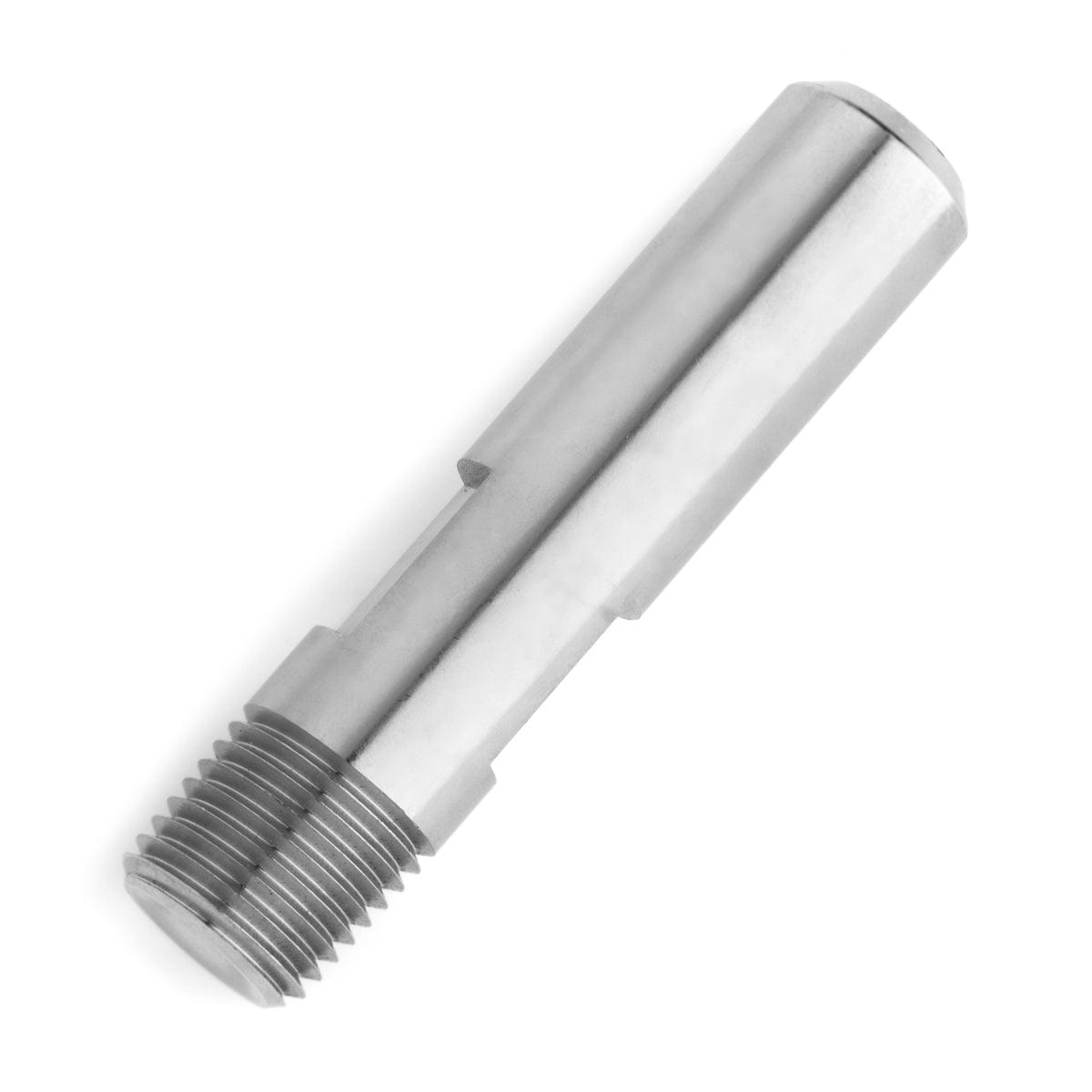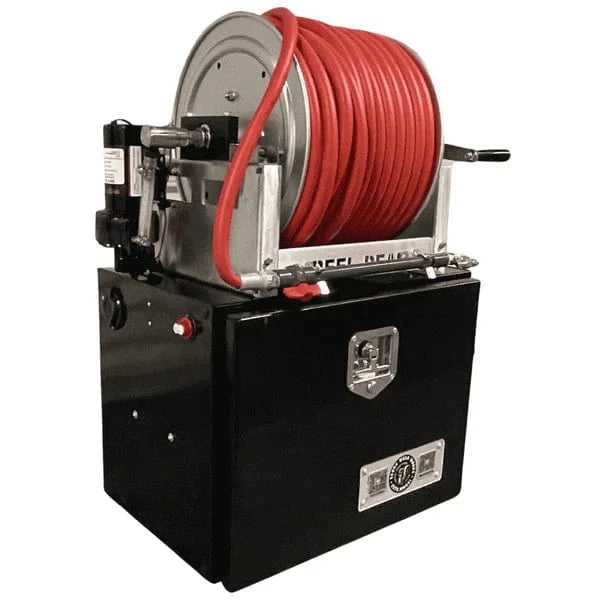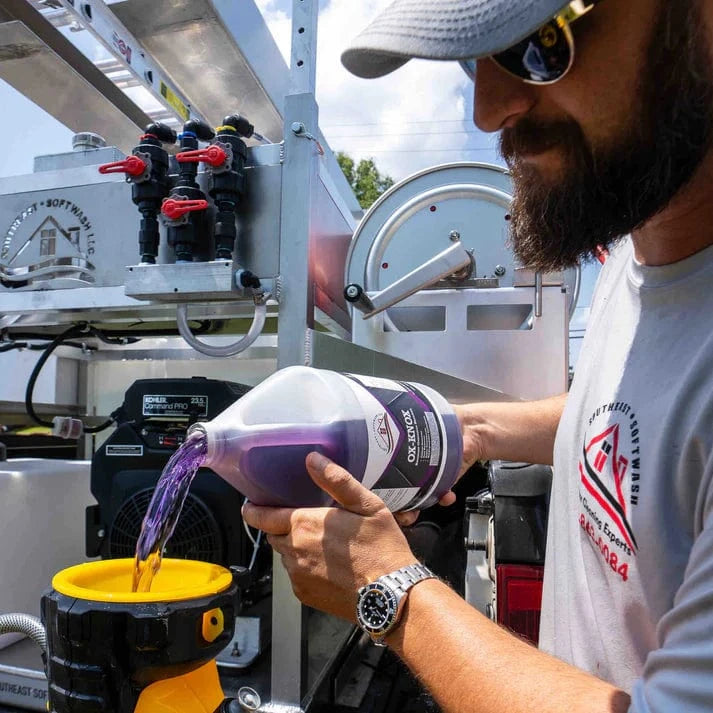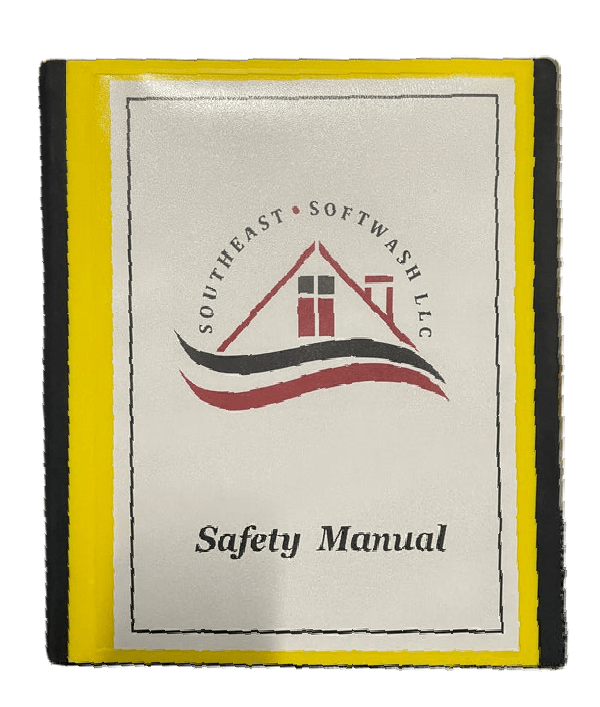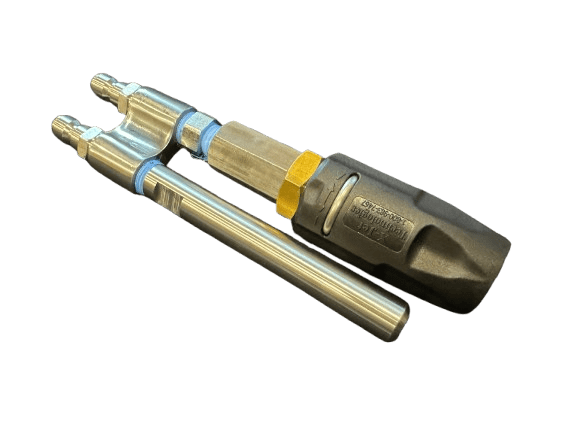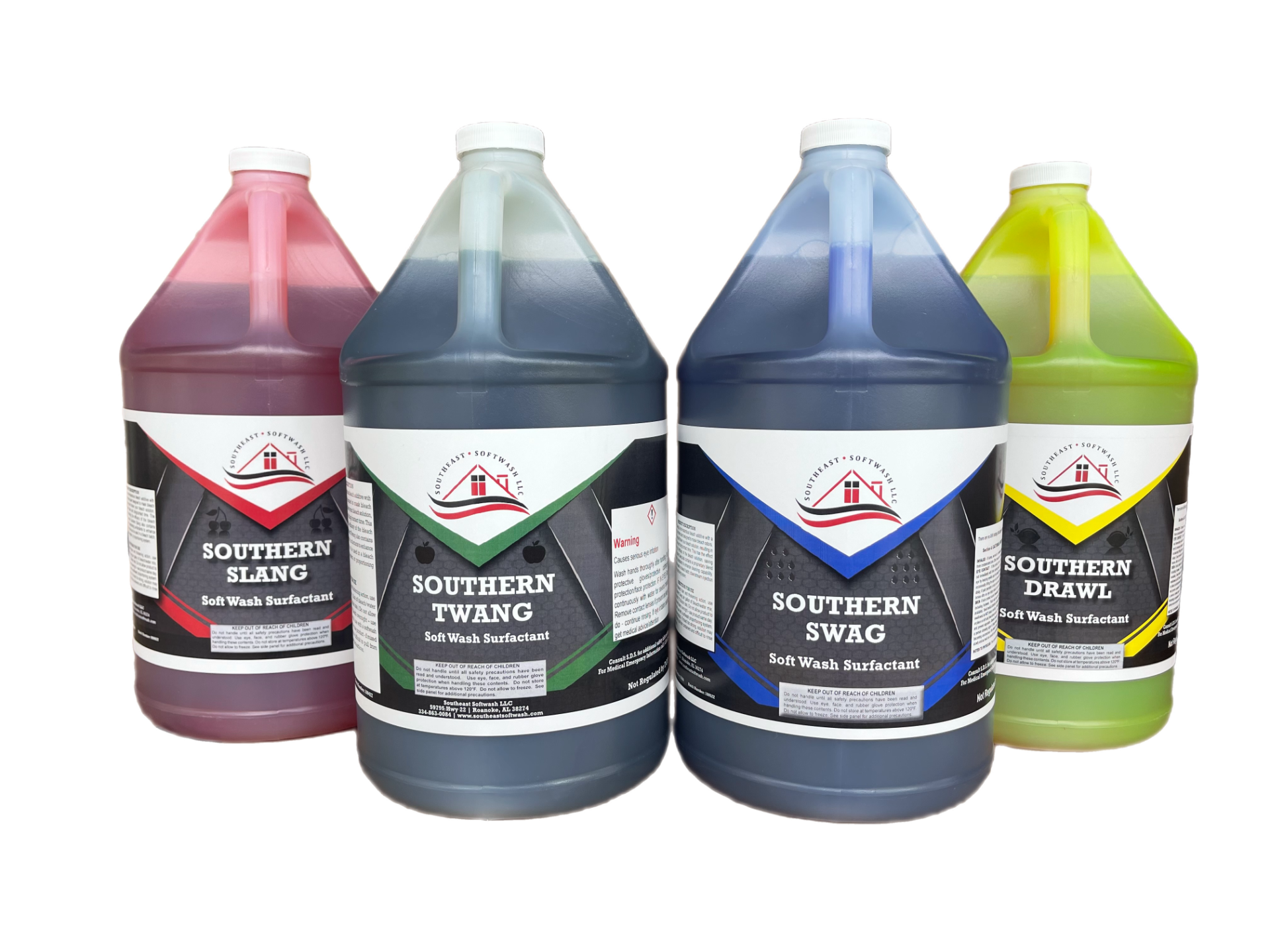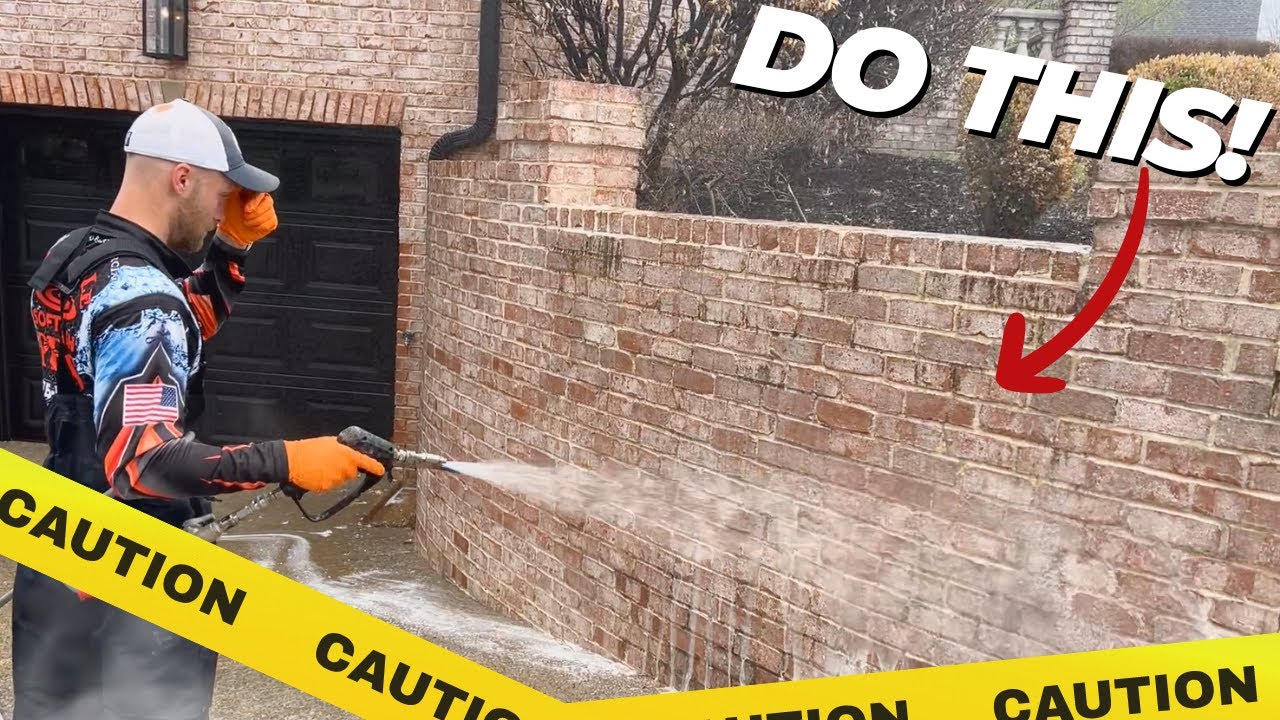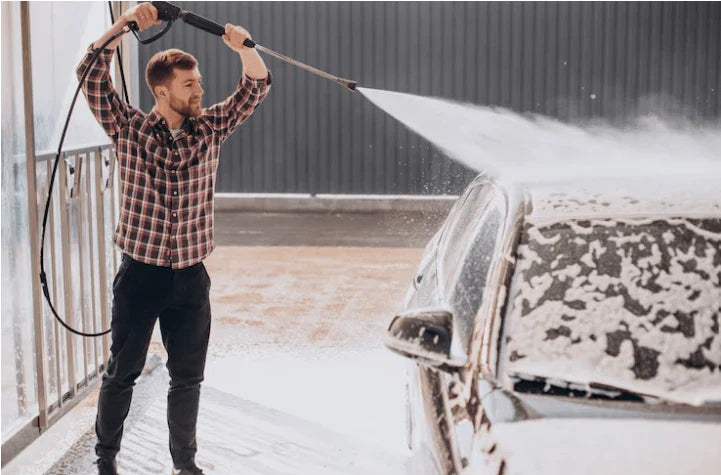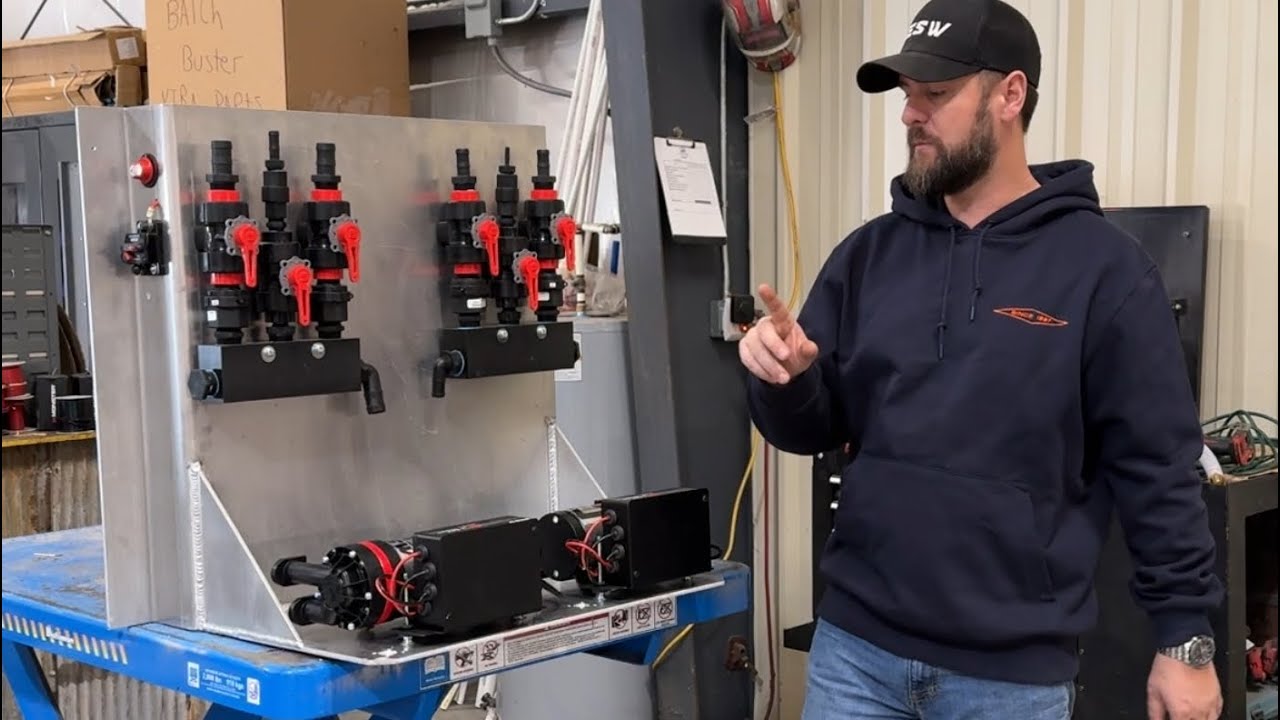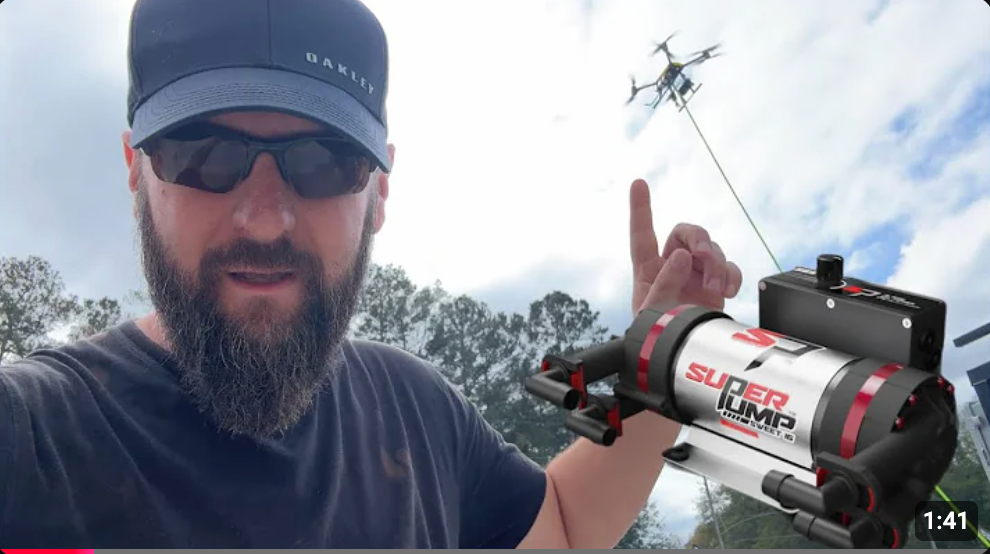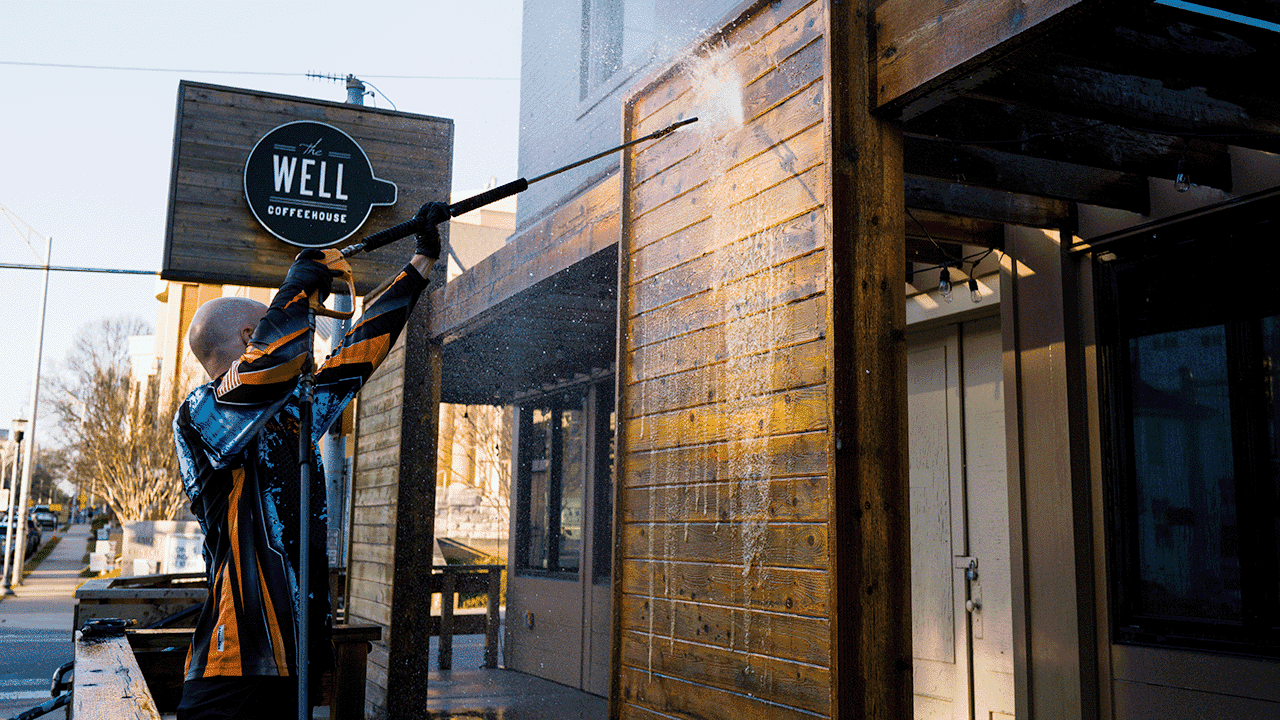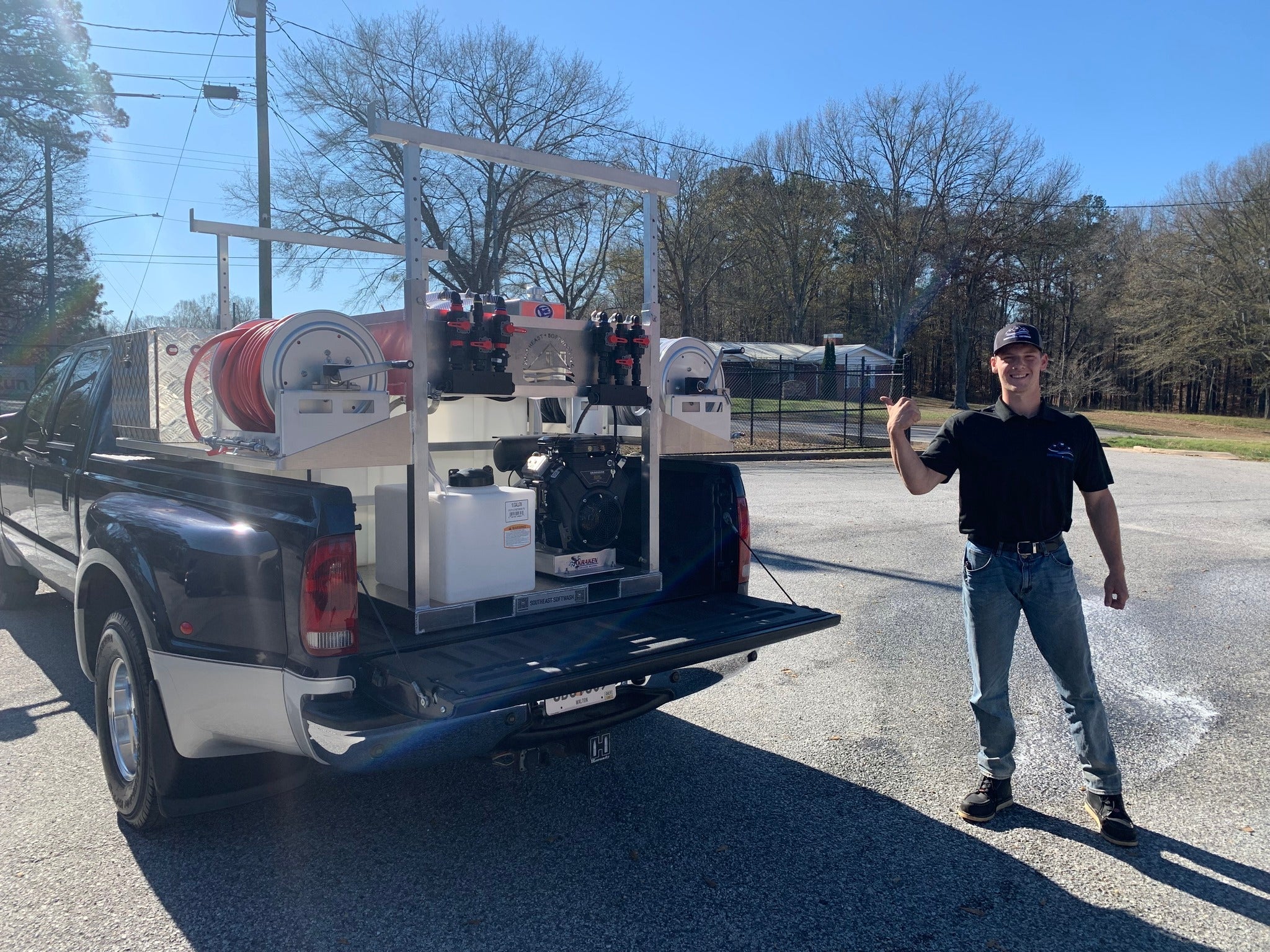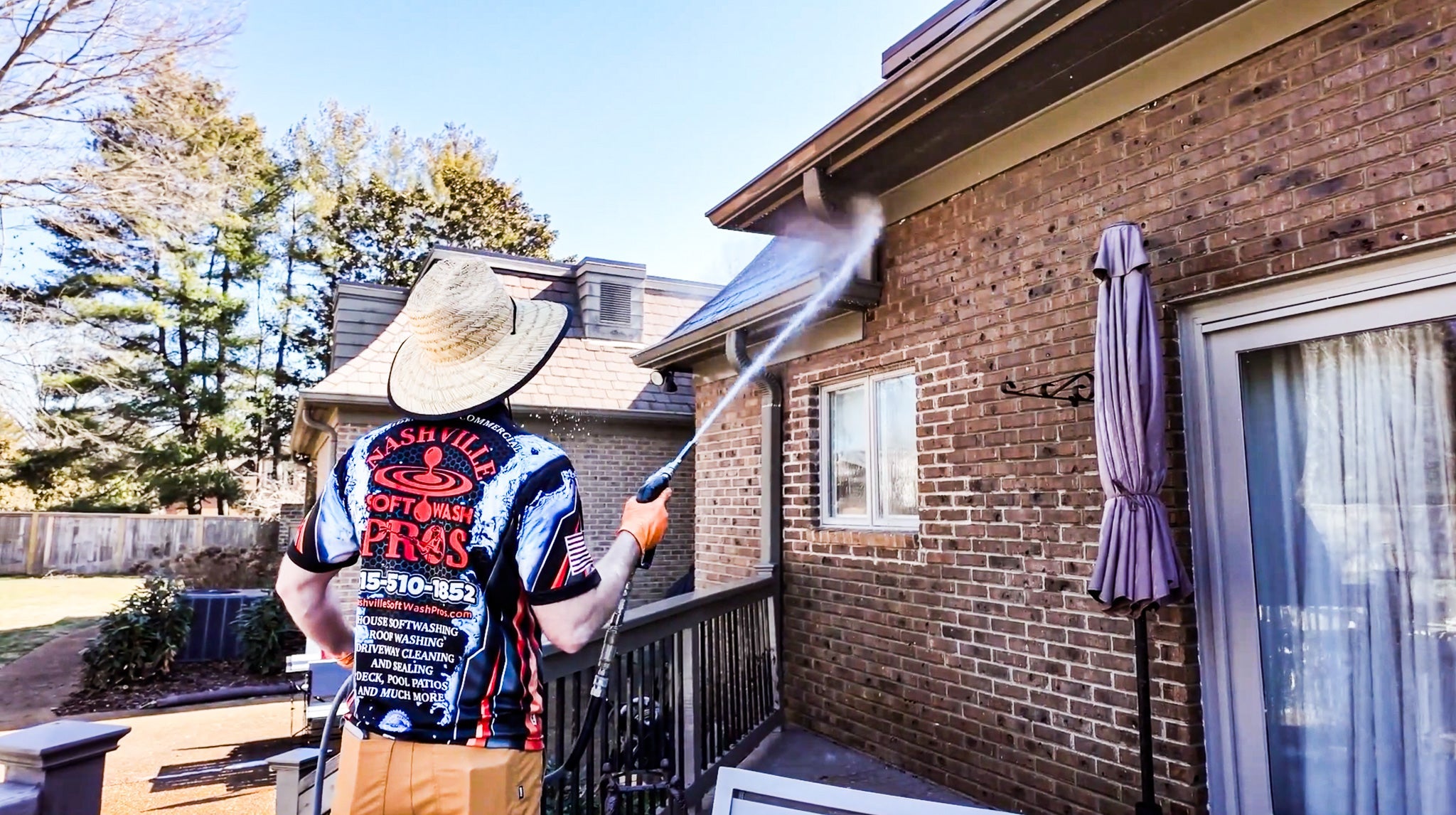There are numerous ways to soft wash your roof and home siding. You can either do it yourself or hire a professional to do the job. Irrespective of your chosen method, this article will guide you about the kind of soft wash chemicals required for soft washing.
Professionals use a blend of professional-grade sodium hypochlorite (12.5%) or parts of bleach mixed with water. These soft wash chemicals help kill primary organisms such as mold, lichen, algae, moss, and mildew that grow on the surface.
For professionals to do safe, efficient and smart soft-washing, additional products are required, which are discussed below in the article.
Soft Washing vs. Power Washing
As similar as soft and power washing may sound, they both use distinctive techniques, pressure, chemicals, and equipment.
Soft washing uses a low-pressure cleaning technique using a blend of bleach, algaecides, surfactants, and water to clean the exteriors with mildew, organic stains, and algae growth.
On the other hand, power washing uses high-pressure water to clean the surface, usually with hot water. So it's ideal to use pressure washing chemicals when power washing.
It would be best if you opted for soft washing surfaces that are difficult to pressure clean or are delicate enough to be damaged by high pressure, such as wooden panels, screens, windows, or roof shingles.
Soft washing was specifically designed to clean algae off the roof shingles.
How To Soft Wash?
Compared to pressure washing, soft washing chemicals use a higher concentration of cleaning solutions and more water-to-chemical ratio, the application is gentle compared to that of a garden hose.
Roof concentrations are usually higher where the chemicals are left on the surface for deep cleaning and ensuring that all organisms are killed. On a siding, it’s usually rinsed off instantly.
Follow these simple steps for a soft wash:
- Prep The Surrounding Area: Protect greenery such as grass or plants surrounding the area that needs to be cleaned.
- Prepare The Solution: Identify what needs to be cleaned and then prepare the solution accordingly.
- Application On The Surface: Once the solution is prepared, load it in a spray bottle. The pump and hose of the spray bottle ensure minimal pressure to run the soft wash.
Chemicals Used To Soft Wash
Before identifying the chemicals, get your hands on a soft wash system. You will need the right kind of nozzle to adjust the pressure. There are several retailers in the market where you can get the equipment, do check out the South East Soft Wash equipment section.
Once the equipment is sorted, we can now proceed to the chemicals:
Surfactants
Bleach takes time to kill the organic matter. When mixed with parts of water, the bleach solution runs quickly down the roof and siding, which is why you need to rinse multiple times since it does not have the staying power.
The process takes up a lot of time, wastes water and bleaches, and threatens the surrounding greenery. Also, bleach does not support the removal of dirt and grime; the water’s pressure may knock them off, but there are no guarantees.
This is where surfactants step in; they are surface-acting agents that minimize the surface tension of water for an even spread. Also, surfactants support the loosening of dirt and grime by deeper penetration which helps rinse the contaminants.
When looking for surfactants, you want them to stick, and nothing is more befitting than the South East Soft Wash products.
-
FRESH RAIN *SOUTHERN SWAG* SURFACTANT
The Southern Swag has a bleach additive suitable for washing, treating concrete, roof cleaning, and more to support the cleaning process. This is an ideal chemical for roof cleaning.
-
CITRUS “SOUTHERN DRAWL” SURFACTANT
The Southern Drawl comes with a fresh citrus scent, suitable for cleaning the roof, concrete, and house washing.
-
CHERRY “SOUTHERN SLANG” SURFACTANT
This Southern Slang surfactant comes with a cherry scent to meet your cleaning needs; prepare the solution with the mentioned ratio, and you are good to go!
The scented cherry solution can hide the bleach smell and replace it with a fresh odor.
-
APPLE *SOUTHERN TWANG* SURFACTANT
This apple-scented Southern Twang surfactant will leave your surroundings smelling of flavourful fruit.
Since the apple-scented surfactant leaves a nice after smell, it can be used to eliminate odors such as smoke, urine, nursing homes, public areas, schools, and any surface where odors are an area of concern.
-
SURFACTANT VARIETY PACK

Comprising a gallon of each of the surfactants, this variety pack includes:
- Southern Drawl
- Southern Slang
- Southern Twang
- Southern Swag
You can avail this variety pack to meet the house’s cleaning needs, concrete, roof, and sides.
How To Use Softwash Chemicals:
Mix the concentrate with the ratio of 15 gallons of water to 1-gallon jug and you are good to go.
2. Bleach Neutralizer
The Plant Protect is a bleach neutralizer that can be sprayed on non-edible outdoor plants and shrubbery before and after bleaching to protect the greenery from damage.

This minimizes chemical exposure to plants. Once you are done bleaching, rinse the plants with water thoroughly, do not leave the product on the plants to dry.
Regularly spraying the trailers, vehicles, and related equipment at the end of the day will help protect the surface from corrosion. Also, the sprayers, fittings, hoses, and pumps can be flushed to avoid premature replacements and repairs.
How To Use Bleach Neutralizer:
- Prep the surface to be treated by thoroughly rinsing it first.
- Mix 5 gal of water with 8-16 oz of the product for low-pressure cleaning and sprays on windows and equipment. The exact ratio applies to X-Jet applications.
- Mix 15-24 oz per 5 gallons of water for downstream injectors.
Adding Plant Protect to your soft washing procedure can help prevent damage to metal fixtures, plants, ornaments, and your reputation.
3. Gutter Cleaner
Gutters need cleaning when they get clogged with debris and leaves, resulting in overflowing of the rainwater and damaging the wall, externally and internally. Numerous tools and chemicals can help you clean the gutter safely and effectively.
Protip: Keep safety protocols in view when using a ladder, and never try to overreach.
Gutter Guard is a cost-effective and highly efficient cleaning solution that requires one quart of Super Concentrate to yield 2-4 gallons of ready-to-use cleaner. You can use it with a spray or soft brush, depending on the severity of the soil on the gutter.
Benefits of Gutter Guard
- Rich In Concentration
- Penetrates Deeply and Quickly
- Cleans Thoroughly And Leaves The Surface Brightened
How To Use Gutter Cleaner (Gutter Guard)
Super easy to use, Gutter Guard Cleaner is highly concentrated. This attractive product can be mixed with two parts water to one part product ratio or three parts water to one part product depending on the severity of cleaning required.
Wet the gutter with this ready-to-use solution or use the pressure washer chemical injector to rinse off with low pressure. The areas that are heavily soiled would require light brushing with a soft brush.
4. Degreaser
A degreaser cleans surfaces such as brick, shingles, fiberglass, limestone, granite, or deep-clean concrete. Dynamite Degreaser effectively cleans alkaline build and concrete. It can be used on driveways, restaurant drive-throughs, gas station surfaces, and dumpster pads.

When used to clean external surfaces, it removes oxidation and unwanted soils. The degreaser helps remove oil, tire, and carbon residues when used on concrete. It also brightens the surface, giving a clean, fresh look.
The Dynamite Degreaser can be used with a low-pressure sprayer, brush, or pressure washer.
How To Use Concrete Degreaser:
- Unlike other cleaning products, Dynamite Degreaser does not mix with bleach. It’s not advisable to dry it on a hot surface.
- Test it on a small surface before covering the full surface to check for compatibility.
- Let the surface dry completely before finally evaluating the results.
5. Rust Stain Remover
-
Rust Rescue Stain Remover
Rust Rescue Stain Remover is high quality and specially designed to remove rust. It is optimal to use on hard surfaces such as concrete or masonry. The product is ideal for removing the stains caused by sprinkler systems or steel structures.

It’s suitable for cleaning red clay stains and yellow stains that ruin the bottom of a boat. This stain remover works well for cleaning battery rust and berry stains.
How To Use Rust Stain Remover
The best way to use the product is with its full strength, allowing it to penetrate fully into the surface that requires cleaning.
6. Mud May-Day Red Clay Stain Cleaner
This product is designed to remove tire tracks, mud marks, and rust stains. Mud May-Day Stain Remover is fume-free and is made to clean stubborn stains and restore the surface to its original form.

How To Use Mud May-Day:
- Test a small area first and then move in sections of 3x5 ft.
- U plastic spray pump can be used to remove the mud and rust stains from the surface, don’t forget to use the product to its full strength.
- For cracks and crevices, use a plastic bristle brush to deep clean. Leave it for 10 minutes for the product to work its magic. You may have to leave the product in for up to 30 mins for old and stubborn stains.
7. Graffiti Remover
Graffiti Defeatii is designed to clean porous surfaces such as granite, slate, brick, and similar characters. The product soaks well into the porous surfaces, and deep cleans through all the layers to remove the paint.

How To Use Graffiti Remover:
- Apply the product liberally on the surface and let it soak in for 10 minutes. Make sure it does not dry.
- Spots on the porous brick may require a second application, and you may need to use high pressure from your pressure washer for stubborn areas.
The Final Word
By now, you have fully understood how these soft washing chemicals work.
Happy Cleaning!


